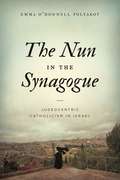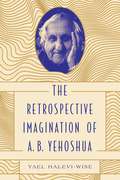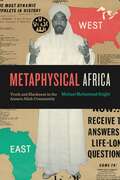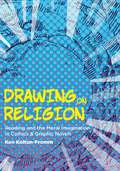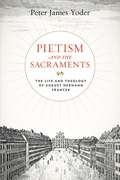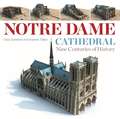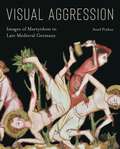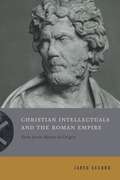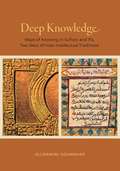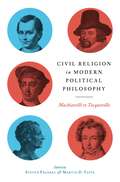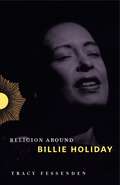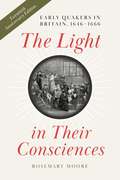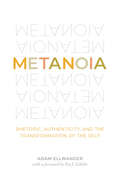- Table View
- List View
The Nun in the Synagogue: Judeocentric Catholicism in Israel
by Emma O’Donnell PolyakovThe Nun in the Synagogue documents the religious and cultural phenomenon of Judeocentric Catholicism that arose in the wake of the Holocaust, fueled by survivors who converted to Catholicism and immigrated to Israel as well as by Catholics determined to address the anti-Judaism inherent in the Church. Through an ethnographic study of selected nuns and monks, Emma O’Donnell Polyakov explores how this Judeocentric Catholic phenomenon began and continues to take shape in Israel.This book is a case study in Catholic perceptions of Jews, Judaism, and the state of Israel during a time of rapidly changing theological and cultural contexts. In it, Polyakov listens to and analyzes the stories of individuals living on the border between Christian and Jewish identity—including Jewish converts to Catholicism who continue to harbor a strong sense of Jewish identity and philosemitic Catholics who attend synagogue services every Shabbat. Polyakov traces the societal, theological, and personal influences that have given rise to this phenomenon and presents a balanced analysis that addresses the hermeneutical problems of interpreting Jews through Christian frameworks. Ultimately, she argues that, despite its problems, this movement signals a pluralistic evolution of Catholic understandings of Judaism and may prove to be a harbinger of future directions in Jewish-Christian relations.Highly original and methodologically sophisticated, The Nun in the Synagogue is a captivating exploration of biographical narratives and reflections on faith, conversion, Holocaust trauma, Zionism, and religious identity that lays the groundwork for future research in the field.
The Retrospective Imagination of A. B. Yehoshua (Dimyonot: Jews and the Cultural Imagination #9)
by Yael Halevi-WiseOnce referred to by the New York Times as the "Israeli Faulkner," A. B. Yehoshua’s fiction invites an assessment of Israel’s Jewish inheritance and the moral and political options that the country currently faces in the Middle East. The Retrospective Imagination of A. B. Yehoshua is an insightful overview of the fiction, nonfiction, and hundreds of critical responses to the work of Israel’s leading novelist.Instead of an exhaustive chronological-biographical account of Yehoshua’s artistic growth, Yael Halevi-Wise calls for a systematic appreciation of the author’s major themes and compositional patterns. Specifically, she argues for reading Yehoshua’s novels as reflections on the "condition of Israel," constructed multifocally to engage four intersecting levels of signification: psychological, sociological, historical, and historiosophic. Each of the book’s seven chapters employs a different interpretive method to showcase how Yehoshua’s constructions of character psychology, social relations, national history, and historiosophic allusions to traditional Jewish symbols manifest themselves across his novels. The book ends with a playful dialogue in the style of Yehoshua’s masterpiece, Mr. Mani, that interrogates his definition of Jewish identity.Masterfully written, with full control of all the relevant materials, Halevi-Wise’s assessment of Yehoshua will appeal to students and scholars of modern Jewish literature and Jewish studies.
The Retrospective Imagination of A. B. Yehoshua (Dimyonot)
by Yael Halevi-WiseOnce referred to by the New York Times as the “Israeli Faulkner,” A. B. Yehoshua’s fiction invites an assessment of Israel’s Jewish inheritance and the moral and political options that the country currently faces in the Middle East. The Retrospective Imagination of A. B. Yehoshua is an insightful overview of the fiction, nonfiction, and hundreds of critical responses to the work of Israel’s leading novelist.Instead of an exhaustive chronological-biographical account of Yehoshua’s artistic growth, Yael Halevi-Wise calls for a systematic appreciation of the author’s major themes and compositional patterns. Specifically, she argues for reading Yehoshua’s novels as reflections on the “condition of Israel,” constructed multifocally to engage four intersecting levels of signification: psychological, sociological, historical, and historiosophic. Each of the book’s seven chapters employs a different interpretive method to showcase how Yehoshua’s constructions of character psychology, social relations, national history, and historiosophic allusions to traditional Jewish symbols manifest themselves across his novels. The book ends with a playful dialogue in the style of Yehoshua’s masterpiece, Mr. Mani, that interrogates his definition of Jewish identity.Masterfully written, with full control of all the relevant materials, Halevi-Wise’s assessment of Yehoshua will appeal to students and scholars of modern Jewish literature and Jewish studies.
Metaphysical Africa: Truth and Blackness in the Ansaru Allah Community (Africana Religions #4)
by Michael Muhammad KnightThe Ansaru Allah Community, also known as the Nubian Islamic Hebrews (AAC/NIH) and later the Nuwaubians, is a deeply significant and controversial African American Muslim movement. Founded in Brooklyn in the 1960s, it spread through the prolific production and dissemination of literature and lecture tapes and became famous for continuously reinventing its belief system. In this book, Michael Muhammad Knight studies the development of AAC/NIH discourse over a period of thirty years, tracing a surprising consistency behind a facade of serial reinvention.It is popularly believed that the AAC/NIH community abandoned Islam for Black Israelite religion, UFO religion, and Egyptosophy. However, Knight sees coherence in AAC/NIH media, explaining how, in reality, the community taught that the Prophet Muhammad was a Hebrew who adhered to Israelite law; Muhammad’s heavenly ascension took place on a spaceship; and Abraham enlisted the help of a pharaonic regime to genetically engineer pigs as food for white people. Against narratives that treat the AAC/NIH community as a postmodernist deconstruction of religious categories, Knight demonstrates that AAC/NIH discourse is most productively framed within a broader African American metaphysical history in which boundaries between traditions remain quite permeable.Unexpected and engrossing, Metaphysical Africa brings to light points of intersection between communities and traditions often regarded as separate and distinct. In doing so, it helps move the field of religious studies beyond conventional categories of "orthodoxy" and "heterodoxy," challenging assumptions that inform not only the study of this particular religious community but also the field at large.
Metaphysical Africa: Truth and Blackness in the Ansaru Allah Community (Africana Religions)
by Michael Muhammad KnightThe Ansaru Allah Community, also known as the Nubian Islamic Hebrews (AAC/NIH) and later the Nuwaubians, is a deeply significant and controversial African American Muslim movement. Founded in Brooklyn in the 1960s, it spread through the prolific production and dissemination of literature and lecture tapes and became famous for continuously reinventing its belief system. In this book, Michael Muhammad Knight studies the development of AAC/NIH discourse over a period of thirty years, tracing a surprising consistency behind a facade of serial reinvention.It is popularly believed that the AAC/NIH community abandoned Islam for Black Israelite religion, UFO religion, and Egyptosophy. However, Knight sees coherence in AAC/NIH media, explaining how, in reality, the community taught that the Prophet Muhammad was a Hebrew who adhered to Israelite law; Muhammad’s heavenly ascension took place on a spaceship; and Abraham enlisted the help of a pharaonic regime to genetically engineer pigs as food for white people. Against narratives that treat the AAC/NIH community as a postmodernist deconstruction of religious categories, Knight demonstrates that AAC/NIH discourse is most productively framed within a broader African American metaphysical history in which boundaries between traditions remain quite permeable.Unexpected and engrossing, Metaphysical Africa brings to light points of intersection between communities and traditions often regarded as separate and distinct. In doing so, it helps move the field of religious studies beyond conventional categories of “orthodoxy” and “heterodoxy,” challenging assumptions that inform not only the study of this particular religious community but also the field at large.
Drawing on Religion: Reading and the Moral Imagination in Comics and Graphic Novels
by Ken Koltun-FrommComics traffic in stereotypes, which can translate into real danger, as was the case when, in 2015, two Muslim gunmen opened fire at the offices of Charlie Hebdo, which had published depictions of Islam and Muhammad perceived by many to be blasphemous. As a response to that tragedy, Ken Koltun-Fromm calls for us to expand our moral imaginations through readings of graphic religious narratives.Utilizing a range of comic books and graphic novels, including R. Crumb’s Book of Genesis Illustrated, Craig Thompson’s Blankets, the Vakil brothers’ 40 Sufi Comics, and Ms. Marvel, Koltun-Fromm argues that representing religion in these formats is an ethical issue. By focusing on the representation of Christian, Jewish, Muslim, and Hindu religious traditions, the comics discussed in this book bear witness to the ethical imagination, the possibilities of traversing religious landscapes, and the problematic status of racial, classed, and gendered characterizations of religious persons. Koltun-Fromm explores what religious stereotypes do and how they function in comics in ways that might expand or diminish our imaginative worlds. The pedagogical challenge, he argues, is to linger in that space and see those worlds well, with both ethical sensitivity and moral imagination.Accessibly written and vibrantly illustrated, this book sheds new light on the ways in which comic arts depict religious faith and culture. It will appeal to students and scholars of religion, literature, and comic studies.
Drawing on Religion: Reading and the Moral Imagination in Comics and Graphic Novels
by Ken Koltun-FrommComics traffic in stereotypes, which can translate into real danger, as was the case when, in 2015, two Muslim gunmen opened fire at the offices of Charlie Hebdo, which had published depictions of Islam and Muhammad perceived by many to be blasphemous. As a response to that tragedy, Ken Koltun-Fromm calls for us to expand our moral imaginations through readings of graphic religious narratives.Utilizing a range of comic books and graphic novels, including R. Crumb’s Book of Genesis Illustrated, Craig Thompson’s Blankets, the Vakil brothers’ 40 Sufi Comics, and Ms. Marvel, Koltun-Fromm argues that representing religion in these formats is an ethical issue. By focusing on the representation of Christian, Jewish, Muslim, and Hindu religious traditions, the comics discussed in this book bear witness to the ethical imagination, the possibilities of traversing religious landscapes, and the problematic status of racial, classed, and gendered characterizations of religious persons. Koltun-Fromm explores what religious stereotypes do and how they function in comics in ways that might expand or diminish our imaginative worlds. The pedagogical challenge, he argues, is to linger in that space and see those worlds well, with both ethical sensitivity and moral imagination.Accessibly written and vibrantly illustrated, this book sheds new light on the ways in which comic arts depict religious faith and culture. It will appeal to students and scholars of religion, literature, and comic studies.
Pietism and the Sacraments: The Life and Theology of August Hermann Francke (Pietist, Moravian, and Anabaptist Studies #6)
by Peter James YoderConsidered by many to be one of the most influential German Pietists, August Hermann Francke lived during a moment when an emphasis on conversion was beginning to produce small shifts in how the sacraments were defined—a harbinger of later, more dramatic changes to come in evangelical theology. In this book, Peter James Yoder uses Francke and his theology as a case study for the ecclesiological stirrings that led to the rise of evangelicalism and global Protestantism.Engaging extensively with Francke’s manuscript sermons and writings, Yoder approaches Francke’s life and religious thought through his theology of the sacraments. In doing so, Yoder delivers key insights into the structure of Francke's Pietist thought, providing a rich depiction of his conversion-driven theology and how it shaped his views of the sacraments and the church. The first in-depth study of Francke’s theology written for an English-speaking audience, this book supports recent scholarship in English that not only challenges long-held assumptions about Pietism but also argues for the role of Pietism’s influence on the changing religious landscape of the eighteenth century. Through his examination of Francke’s theology of the sacraments, Yoder presents a fresh view into the eighteenth-century ecclesiological developments that caused a rupture with the dogmas of the Reformation.Original and vital, this study recognizes Francke’s importance to the history of Pietism in Germany and beyond. It will become the standard reference on Francke for American audiences and will influence scholarship on Lutheranism, Pietism, early modern German studies, and eighteenth-century history and religion.
Pietism and the Sacraments: The Life and Theology of August Hermann Francke (Pietist, Moravian, and Anabaptist Studies)
by Peter James YoderConsidered by many to be one of the most influential German Pietists, August Hermann Francke lived during a moment when an emphasis on conversion was beginning to produce small shifts in how the sacraments were defined—a harbinger of later, more dramatic changes to come in evangelical theology. In this book, Peter James Yoder uses Francke and his theology as a case study for the ecclesiological stirrings that led to the rise of evangelicalism and global Protestantism.Engaging extensively with Francke’s manuscript sermons and writings, Yoder approaches Francke’s life and religious thought through his theology of the sacraments. In doing so, Yoder delivers key insights into the structure of Francke's Pietist thought, providing a rich depiction of his conversion-driven theology and how it shaped his views of the sacraments and the church. The first in-depth study of Francke’s theology written for an English-speaking audience, this book supports recent scholarship in English that not only challenges long-held assumptions about Pietism but also argues for the role of Pietism’s influence on the changing religious landscape of the eighteenth century. Through his examination of Francke’s theology of the sacraments, Yoder presents a fresh view into the eighteenth-century ecclesiological developments that caused a rupture with the dogmas of the Reformation.Original and vital, this study recognizes Francke’s importance to the history of Pietism in Germany and beyond. It will become the standard reference on Francke for American audiences and will influence scholarship on Lutheranism, Pietism, early modern German studies, and eighteenth-century history and religion.
Notre Dame Cathedral: Nine Centuries of History
by Andrew Tallon Dany SandronSince its construction, Notre Dame Cathedral has played a central role in French cultural identity. In the wake of the tragic fire of 2019, questions of how to restore the fabric of this quintessential French monument are once more at the forefront. This all-too-prescient book, first published in French in 2013, takes a central place in the conversation. The Gothic cathedral par excellence, Notre Dame set the architectural bar in the competitive years of the third quarter of the twelfth century and dazzled the architects and aesthetes of the Enlightenment with its structural ingenuity. In the nineteenth century, the cathedral became the touchstone of a movement to restore medieval patrimony to its rightful place at the cultural heart of France: it was transformed into a colossal laboratory in which architects Jean-Baptiste Lassus and Eugène-Emmanuel Viollet-le-Duc anatomized structures, dismembered them, put them back, or built them anew—all the while documenting their work with scientific precision.Taking as their point of departure a three-dimensional laser scan of the cathedral created in 2010, architectural historians Dany Sandron and the late Andrew Tallon tell the story of the construction and reconstruction of Notre Dame in visual terms. With over a billion points of data, the scan supplies a highly accurate spatial map of the building, which is anatomized and rebuilt virtually. Fourteen double-page images represent the cathedral at specific points in time, while the accompanying text sets out the history of the building, addressing key topics such as the fundraising campaign, the construction of the vaults, and the liturgical function of the choir. Featuring 170 full-color illustrations and elegantly translated by Andrew Tallon and Lindsay Cook, Notre Dame Cathedral is an enlightening history of one of the world’s most treasured architectural achievements.
Notre Dame Cathedral: Nine Centuries of History
by Andrew Tallon Dany SandronSince its construction, Notre Dame Cathedral has played a central role in French cultural identity. In the wake of the tragic fire of 2019, questions of how to restore the fabric of this quintessential French monument are once more at the forefront. This all-too-prescient book, first published in French in 2013, takes a central place in the conversation. The Gothic cathedral par excellence, Notre Dame set the architectural bar in the competitive years of the third quarter of the twelfth century and dazzled the architects and aesthetes of the Enlightenment with its structural ingenuity. In the nineteenth century, the cathedral became the touchstone of a movement to restore medieval patrimony to its rightful place at the cultural heart of France: it was transformed into a colossal laboratory in which architects Jean-Baptiste Lassus and Eugène-Emmanuel Viollet-le-Duc anatomized structures, dismembered them, put them back, or built them anew—all the while documenting their work with scientific precision.Taking as their point of departure a three-dimensional laser scan of the cathedral created in 2010, architectural historians Dany Sandron and the late Andrew Tallon tell the story of the construction and reconstruction of Notre Dame in visual terms. With over a billion points of data, the scan supplies a highly accurate spatial map of the building, which is anatomized and rebuilt virtually. Fourteen double-page images represent the cathedral at specific points in time, while the accompanying text sets out the history of the building, addressing key topics such as the fundraising campaign, the construction of the vaults, and the liturgical function of the choir. Featuring 170 full-color illustrations and elegantly translated by Andrew Tallon and Lindsay Cook, Notre Dame Cathedral is an enlightening history of one of the world’s most treasured architectural achievements.
Visual Aggression: Images of Martyrdom in Late Medieval Germany
by Assaf PinkusWhy does a society seek out images of violence? What can the consumption of violent imagery teach us about the history of violence and the ways in which it has been represented and understood? Assaf Pinkus considers these questions within the context of what he calls galleries of violence, the torment imagery that flourished in German-speaking regions during the fourteenth and fifteenth centuries. Exploring these images and the visceral bodily responses that they produced in their viewers, Pinkus argues that the new visual discourse on violence was a watershed in premodern conceptualizations of selfhood.Images of martyrdom in late medieval Germany reveal a strikingly brutal parade of passion: severed heads, split skulls, mutilated organs, extracted fingernails and teeth, and myriad other torments. Stripped from their devotional context and presented simply as brutal acts, these portrayals assailed viewers’ bodies and minds so violently that they amounted to what Pinkus describes as "visual aggressions." Addressing contemporary discourses on violence and cruelty, the aesthetics of violence, and the eroticism of the tortured body, Pinkus ties these galleries of violence to larger cultural concerns about the ethics of violence and bodily integrity in the conceptualization of early modern personhood.Innovative and convincing, this study heralds a fundamental shift in the scholarly conversation about premodern violence, moving from a focus on the imitatio Christi and the liturgy of punishment to the notion of violence as a moral problem in an ethical system. Scholars of medieval and early modern art, history, and literature will welcome and engage with Pinkus’s research for years to come.
Visual Aggression: Images of Martyrdom in Late Medieval Germany
by Assaf PinkusWhy does a society seek out images of violence? What can the consumption of violent imagery teach us about the history of violence and the ways in which it has been represented and understood? Assaf Pinkus considers these questions within the context of what he calls galleries of violence, the torment imagery that flourished in German-speaking regions during the fourteenth and fifteenth centuries. Exploring these images and the visceral bodily responses that they produced in their viewers, Pinkus argues that the new visual discourse on violence was a watershed in premodern conceptualizations of selfhood.Images of martyrdom in late medieval Germany reveal a strikingly brutal parade of passion: severed heads, split skulls, mutilated organs, extracted fingernails and teeth, and myriad other torments. Stripped from their devotional context and presented simply as brutal acts, these portrayals assailed viewers’ bodies and minds so violently that they amounted to what Pinkus describes as “visual aggressions.” Addressing contemporary discourses on violence and cruelty, the aesthetics of violence, and the eroticism of the tortured body, Pinkus ties these galleries of violence to larger cultural concerns about the ethics of violence and bodily integrity in the conceptualization of early modern personhood.Innovative and convincing, this study heralds a fundamental shift in the scholarly conversation about premodern violence, moving from a focus on the imitatio Christi and the liturgy of punishment to the notion of violence as a moral problem in an ethical system. Scholars of medieval and early modern art, history, and literature will welcome and engage with Pinkus’s research for years to come.
Christian Intellectuals and the Roman Empire: From Justin Martyr to Origen (Inventing Christianity #2)
by Jared SecordEarly in the third century, a small group of Greek Christians began to gain prominence and legitimacy as intellectuals in the Roman Empire. Examining the relationship that these thinkers had with the broader Roman intelligentsia, Jared Secord contends that the success of Christian intellectualism during this period had very little to do with Christianity itself.With the recognition that Christian authors were deeply engaged with the norms and realities of Roman intellectual culture, Secord examines the thought of a succession of Christian literati that includes Justin Martyr, Tatian, Julius Africanus, and Origen, comparing each to a diverse selection of his non-Christian contemporaries. Reassessing Justin’s apologetic works, Secord reveals Christian views on martyrdom to be less distinctive than previously believed. He shows that Tatian’s views on Greek culture informed his reception by Christians as a heretic. Finally, he suggests that the successes experienced by Africanus and Origen in the third century emerged as consequences not of any change in attitude toward Christianity by imperial authorities but of a larger shift in intellectual culture and imperial policies under the Severan dynasty. Original and erudite, this volume demonstrates how distorting the myopic focus on Christianity as a religion has been in previous attempts to explain the growth and success of the Christian movement. It will stimulate new research in the study of early Christianity, classical studies, and Roman history.
Christian Intellectuals and the Roman Empire: From Justin Martyr to Origen (Inventing Christianity)
by Jared SecordEarly in the third century, a small group of Greek Christians began to gain prominence and legitimacy as intellectuals in the Roman Empire. Examining the relationship that these thinkers had with the broader Roman intelligentsia, Jared Secord contends that the success of Christian intellectualism during this period had very little to do with Christianity itself.With the recognition that Christian authors were deeply engaged with the norms and realities of Roman intellectual culture, Secord examines the thought of a succession of Christian literati that includes Justin Martyr, Tatian, Julius Africanus, and Origen, comparing each to a diverse selection of his non-Christian contemporaries. Reassessing Justin’s apologetic works, Secord reveals Christian views on martyrdom to be less distinctive than previously believed. He shows that Tatian’s views on Greek culture informed his reception by Christians as a heretic. Finally, he suggests that the successes experienced by Africanus and Origen in the third century emerged as consequences not of any change in attitude toward Christianity by imperial authorities but of a larger shift in intellectual culture and imperial policies under the Severan dynasty. Original and erudite, this volume demonstrates how distorting the myopic focus on Christianity as a religion has been in previous attempts to explain the growth and success of the Christian movement. It will stimulate new research in the study of early Christianity, classical studies, and Roman history.
Deep Knowledge: Ways of Knowing in Sufism and Ifa, Two West African Intellectual Traditions (Africana Religions #5)
by Oludamini OgunnaikeThis book is an in-depth, comparative study of two of the most popular and influential intellectual and spiritual traditions of West Africa: Tijani Sufism and Ifa. Employing a unique methodological approach that thinks with and from—rather than merely about—these traditions, Oludamini Ogunnaike argues that they contain sophisticated epistemologies that provide practitioners with a comprehensive worldview and a way of crafting a meaningful life.Using theories belonging to the traditions themselves as well as contemporary oral and textual sources, Ogunnaike examines how both Sufism and Ifa answer the questions of what knowledge is, how it is acquired, and how it is verified. Or, more simply: What do you know? How did you come to know it? How do you know that you know? After analyzing Ifa and Sufism separately and on their own terms, the book compares them to each other and to certain features of academic theories of knowledge. By analyzing Sufism from the perspective of Ifa, Ifa from the perspective of Sufism, and the contemporary academy from the perspective of both, this book invites scholars to inhabit these seemingly "foreign" intellectual traditions as valid and viable perspectives on knowledge, metaphysics, psychology, and ritual practice.Unprecedented and innovative, Deep Knowledge makes a significant contribution to cross-cultural philosophy, African philosophy, religious studies, and Islamic studies. Its singular approach advances our understanding of the philosophical bases underlying these two African traditions and lays the groundwork for future study.
Deep Knowledge: Ways of Knowing in Sufism and Ifa, Two West African Intellectual Traditions (Africana Religions)
by Oludamini OgunnaikeThis book is an in-depth, comparative study of two of the most popular and influential intellectual and spiritual traditions of West Africa: Tijani Sufism and Ifa. Employing a unique methodological approach that thinks with and from—rather than merely about—these traditions, Oludamini Ogunnaike argues that they contain sophisticated epistemologies that provide practitioners with a comprehensive worldview and a way of crafting a meaningful life.Using theories belonging to the traditions themselves as well as contemporary oral and textual sources, Ogunnaike examines how both Sufism and Ifa answer the questions of what knowledge is, how it is acquired, and how it is verified. Or, more simply: What do you know? How did you come to know it? How do you know that you know? After analyzing Ifa and Sufism separately and on their own terms, the book compares them to each other and to certain features of academic theories of knowledge. By analyzing Sufism from the perspective of Ifa, Ifa from the perspective of Sufism, and the contemporary academy from the perspective of both, this book invites scholars to inhabit these seemingly “foreign” intellectual traditions as valid and viable perspectives on knowledge, metaphysics, psychology, and ritual practice.Unprecedented and innovative, Deep Knowledge makes a significant contribution to cross-cultural philosophy, African philosophy, religious studies, and Islamic studies. Its singular approach advances our understanding of the philosophical bases underlying these two African traditions and lays the groundwork for future study.
Civil Religion in Modern Political Philosophy: Machiavelli to Tocqueville
by Martin D. Yaffe Steven FrankelInspired by Machiavelli, modern philosophers held that the tension between the goals of biblical piety and the goals of political life needed to be resolved in favor of the political, and they attempted to recast and delimit traditional Christian teaching to serve and stabilize political life accordingly. This volume examines the arguments of those thinkers who worked to remake Christianity into a civil religion in the early modern and modern periods.Beginning with Machiavelli and continuing through to Alexis de Tocqueville, the essays in this collection explain in detail the ways in which these philosophers used religious and secular writing to build a civil religion in the West. Early chapters examine topics such as Machiavelli’s comparisons of Christianity with Roman religion, Francis Bacon’s cherry-picking of Christian doctrines in the service of scientific innovation, and Spinoza’s attempt to replace long-held superstitions with newer, "progressive" ones. Other essays probe the scripture-based, anti-Christian argument that religion must be subordinate to politics espoused by Jean-Jacques Rousseau and David Hume, both of whom championed reason over divine authority. Crucially, the book also includes a study of civil religion in America, with chapters on John Locke, Montesquieu, and the American Founders illuminating the relationships among religious and civil history, acts, and authority. The last chapter is an examination of Tocqueville’s account of civil religion and the American regimeDetailed, thought-provoking, and based on the careful study of original texts, this survey of religion and politics in the West will appeal to scholars in the history of political philosophy, political theory, and American political thought.
Civil Religion in Modern Political Philosophy: Machiavelli to Tocqueville
by Martin D. Yaffe Steven FrankelInspired by Machiavelli, modern philosophers held that the tension between the goals of biblical piety and the goals of political life needed to be resolved in favor of the political, and they attempted to recast and delimit traditional Christian teaching to serve and stabilize political life accordingly. This volume examines the arguments of those thinkers who worked to remake Christianity into a civil religion in the early modern and modern periods.Beginning with Machiavelli and continuing through to Alexis de Tocqueville, the essays in this collection explain in detail the ways in which these philosophers used religious and secular writing to build a civil religion in the West. Early chapters examine topics such as Machiavelli’s comparisons of Christianity with Roman religion, Francis Bacon’s cherry-picking of Christian doctrines in the service of scientific innovation, and Spinoza’s attempt to replace long-held superstitions with newer, “progressive” ones. Other essays probe the scripture-based, anti-Christian argument that religion must be subordinate to politics espoused by Jean-Jacques Rousseau and David Hume, both of whom championed reason over divine authority. Crucially, the book also includes a study of civil religion in America, with chapters on John Locke, Montesquieu, and the American Founders illuminating the relationships among religious and civil history, acts, and authority. The last chapter is an examination of Tocqueville’s account of civil religion and the American regime.Detailed, thought-provoking, and based on the careful study of original texts, this survey of religion and politics in the West will appeal to scholars in the history of political philosophy, political theory, and American political thought.
Religion Around Billie Holiday (Religion Around #3)
by Tracy FessendenSoulful jazz singer Billie Holiday is remembered today for her unique sound, troubled personal history, and a catalogue that includes such resonant songs as "Strange Fruit" and "God Bless the Child." Holiday and her music were also strongly shaped by religion, often in surprising ways. Religion Around Billie Holiday examines the spiritual and religious forces that left their mark on the performer during her short but influential life.Mixing elements of biography with the history of race and American music, Tracy Fessenden explores the multiple religious influences on Holiday’s life and sound, including her time spent as a child in a Baltimore convent, the echoes of black Southern churches in the blues she encountered in brothels, the secular riffs on ancestral faith in the poetry of the Harlem Renaissance, and the Jewish songwriting culture of Tin Pan Alley. Fessenden looks at the vernacular devotions scholars call lived religion—the Catholicism of the streets, the Jewishness of the stage, the Pentecostalism of the roadhouse or the concert arena—alongside more formal religious articulations in institutions, doctrine, and ritual performance.Insightful and compelling, Fessenden’s study brings unexpected materials and archival voices to bear on the shaping of Billie Holiday’s exquisite craft and indelible persona. Religion Around Billie Holiday illuminates the power and durability of religion in the making of an American musical icon.
Religion Around Billie Holiday (Religion Around)
by Tracy FessendenSoulful jazz singer Billie Holiday is remembered today for her unique sound, troubled personal history, and a catalogue that includes such resonant songs as “Strange Fruit” and “God Bless the Child.” Holiday and her music were also strongly shaped by religion, often in surprising ways. Religion Around Billie Holiday examines the spiritual and religious forces that left their mark on the performer during her short but influential life.Mixing elements of biography with the history of race and American music, Tracy Fessenden explores the multiple religious influences on Holiday’s life and sound, including her time spent as a child in a Baltimore convent, the echoes of black Southern churches in the blues she encountered in brothels, the secular riffs on ancestral faith in the poetry of the Harlem Renaissance, and the Jewish songwriting culture of Tin Pan Alley. Fessenden looks at the vernacular devotions scholars call lived religion—the Catholicism of the streets, the Jewishness of the stage, the Pentecostalism of the roadhouse or the concert arena—alongside more formal religious articulations in institutions, doctrine, and ritual performance.Insightful and compelling, Fessenden’s study brings unexpected materials and archival voices to bear on the shaping of Billie Holiday’s exquisite craft and indelible persona. Religion Around Billie Holiday illuminates the power and durability of religion in the making of an American musical icon.
The Light in Their Consciences: Early Quakers in Britain, 1646–1666 (The New History of Quakerism #1)
by Rosemary MooreHailed upon its publication as "history at its finest" by H. Larry Ingle and called "the essential foundation to explore early Quaker history" by Sixteenth Century Journal, Rosemary Moore’s The Light in Their Consciences is the most comprehensive, readable history of the first decades of the life and thought of The Society of Friends. This twentieth anniversary edition of Moore’s pathbreaking work reintroduces the book to a new generation of readers.Drawing on an innovative computer-based analysis of primary sources and Quaker and anti-Quaker literature, Moore provides compelling portraits of George Fox, James Nayler, Margaret Fell, and other leading figures; relates how the early Friends lived and worshipped; and traces the path this radical group followed as it began its development into a denomination. In doing so, she makes clear the origins and evolution of Quaker faith, details how they overcame differences in doctrinal interpretation and religious practice, and delves deeply into clashes between and among leaders and lay practitioners. Thoroughly researched, felicitously written, and featuring a new introduction, updated sources, and an enlightening outline of Moore’s research methodology, this edition of The Light in Their Consciences belongs in the collection of everyone interested in or studying Quaker history and the era in which the movement originated.
The Light in Their Consciences: Early Quakers in Britain, 1646–1666 (The New History of Quakerism)
by Rosemary MooreHailed upon its publication as “history at its finest” by H. Larry Ingle and called “the essential foundation to explore early Quaker history” by Sixteenth Century Journal, Rosemary Moore’s The Light in Their Consciences is the most comprehensive, readable history of the first decades of the life and thought of The Society of Friends. This twentieth anniversary edition of Moore’s pathbreaking work reintroduces the book to a new generation of readers.Drawing on an innovative computer-based analysis of primary sources and Quaker and anti-Quaker literature, Moore provides compelling portraits of George Fox, James Nayler, Margaret Fell, and other leading figures; relates how the early Friends lived and worshipped; and traces the path this radical group followed as it began its development into a denomination. In doing so, she makes clear the origins and evolution of Quaker faith, details how they overcame differences in doctrinal interpretation and religious practice, and delves deeply into clashes between and among leaders and lay practitioners. Thoroughly researched, felicitously written, and featuring a new introduction, updated sources, and an enlightening outline of Moore’s research methodology, this edition of The Light in Their Consciences belongs in the collection of everyone interested in or studying Quaker history and the era in which the movement originated.
Metanoia: Rhetoric, Authenticity, and the Transformation of the Self (G - Reference, Information And Interdisciplinary Subjects Ser.)
by Adam EllwangerWestern culture is in a moment when wholly new kinds of personal transformations are possible, but authentic transformation requires both personal testimony and public recognition. In this book, Adam Ellwanger takes a distinctly rhetorical approach to analyzing how the personal and the public relate to an individual’s transformation and develops a new vocabulary that enables a critical assessment of the concept of authenticity. The concept of metanoia is central to this project. Charting the history of metanoia from its original use in the classical tradition to its adoption by early Christians as a term for religious conversion, Ellwanger shows that metanoia involves a change within a person that results in a truer version of him- or herself—a change in character or ethos. He then applies this theory to our contemporary moment, finding that metanoia provides unique insight into modern forms of self-transformation. Drawing on ancient and medieval sources, including Thucydides, Plato, Paul the Apostle, and Augustine, as well as contemporary discourses of self-transformation, such as the public testimonies of Caitlyn Jenner and Rachel Dolezal, Ellwanger elucidates the role of language in signifying and authenticating identity. Timely and original, Ellwanger’s study formulates a transhistorical theory of personal transformation that will be of interest to scholars working in social theory, philosophy, rhetoric, and the history of Christianity.
Metanoia: Rhetoric, Authenticity, and the Transformation of the Self
by Adam EllwangerWestern culture is in a moment when wholly new kinds of personal transformations are possible, but authentic transformation requires both personal testimony and public recognition. In this book, Adam Ellwanger takes a distinctly rhetorical approach to analyzing how the personal and the public relate to an individual’s transformation and develops a new vocabulary that enables a critical assessment of the concept of authenticity. The concept of metanoia is central to this project. Charting the history of metanoia from its original use in the classical tradition to its adoption by early Christians as a term for religious conversion, Ellwanger shows that metanoia involves a change within a person that results in a truer version of him- or herself—a change in character or ethos. He then applies this theory to our contemporary moment, finding that metanoia provides unique insight into modern forms of self-transformation. Drawing on ancient and medieval sources, including Thucydides, Plato, Paul the Apostle, and Augustine, as well as contemporary discourses of self-transformation, such as the public testimonies of Caitlyn Jenner and Rachel Dolezal, Ellwanger elucidates the role of language in signifying and authenticating identity. Timely and original, Ellwanger’s study formulates a transhistorical theory of personal transformation that will be of interest to scholars working in social theory, philosophy, rhetoric, and the history of Christianity.
